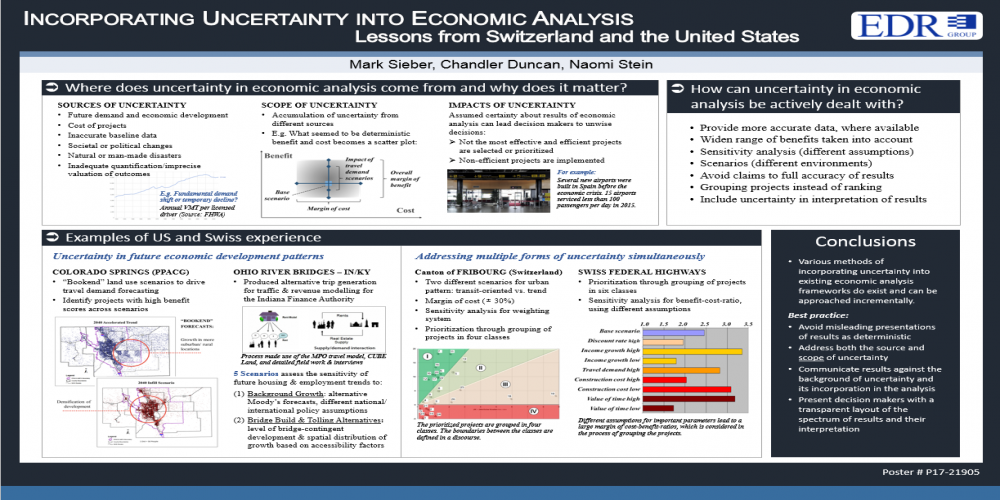Blog
Changes in the administration, debates in Washington, and ongoing developments in technology, climate change and infrastructure costs make it harder than ever to undertake meaningful transportation plans, corridor studies and prioritize public investments.
Tags:
#TRBAM
It is the often untold story of project evaluations: We can never be fully certain about the results. Whether it is about the selection of the best alternative for a project or about setting priorities among different projects, the results depend to a considerable extent on assumptions we make. Assumptions are embedded in our analytical choices and results: what are the appropriate weights for each factor in a multicriteria analysis? How about the discount rate in a BCA? How accurate are the data sources we rely on? Do we truly know how much a project will cost or the level of future demand?
Tags:
#TRBAM
The Swiss Federal Offices for Spatial Development, Roads, Transportation, the Environment and Energy jointly released the new Transport Outlook 2040. Ernst Basler + Partner (www.ebp.ch), based in Zurich and an affiliate of EDR Group, worked on this project in collaboration with two other companies. The firm performed the passenger transportation forecast and for the modelling of impacts. The report offers intriguing findings that may be of interest for transportation and land use planners in the US and worldwide.
Tags:
#TRBAM
nput-output (I-O) analysis is an important technique used to estimate how changes in one sector of the economy affect employment, wages, and overall production in other sectors. An economist named Wassily Leontief developed the technique decades ago, receiving the 1973 Nobel Memorial Prize in Economic Sciences for doing so. Today, analysts customize national I-O “accounts” produced by the U.S. Bureau of Economic Analysis in order to study regional (sub-national) effects. These accounts describe how industries, households, and government exchange goods and services, and regional models, in turn, use this information to simulate the magnitude, direction, and timing of economic impacts.
Tags:
On June 17th, 2013 a WSJ article entitled “Rail Safety and the Value of a Life[1]” highlighted the financial struggles that regional transit transportation authorities are facing to address safety concerns: both avoiding train crashes and improving deteriorating bridges. A federal requirement to install anti-crash gear (Positive Train Control – PTC) for all transit systems that carry over 564 million passengers by 2015 is currently being discussed by the Senate Commerce Committee. While there is debate over prioritizing schedules of investing in PTC versus the backlog of needed bridge renovations, it highlights the urgent need for overall additional investment in transit infrastructure
Tags:
How would you rank the following tools –hammer, screwdriver and pliers? Now you might ask: Why would anyone ask such a silly question …for each is appropriate for a different use (even though I could bang a nail with a pliers or screwdriver). Well, it is not very different when someone catalogs all of the various types and brands of “economic” software tools and throws together tools for evaluating user benefits, regional economic impacts, land use impacts and economic development targeting into the same list. Yes, they may all have some common economic element (like putting a $ value on time or access), but each has a different intended use.
Tags:
The idea of infrastructure as a necessary ingredient for U.S. economic growth is as old as the republic. Recently, EDR Group completed a series of studies for the American Society of Civil Engineers where we looked at different types of infrastructure and addressed the question of what would happen in the national economy if the infrastructure we have in place decays. The real stories in all four studies are in dollars that will be lost to the nation. The country’s infrastructure is aging, and not keeping pace with population and employment growth. This jeopardizes clean water delivery, sewer and wastewater services, and access to reliable electricity and transportation. These impacts in turn affect locations of businesses and households, and will cost them money as they compensate for poor services.
Tags:
Drivers of Behavior: Needs and Fears. Infrastructure planning and policy calls for decision-making that must be justifiable and stand up to public scrutiny. And that means considering not only impacts on users or customers, but also consideration of other factors such as wider economic benefits. And herein lies a problem, for one of the greatest fears of public agency staff is being caught unable to explain the justification for a decision or the logic process by which the wider benefits and costs were estimated.
Tags:
“Can’t live without them, and we can’t get enough of them” has been a constant public sector mantra since the call to action in early 2009 through the federal stimulus known as ARRA (American Reinvestment & Recovery Act). The need for validation and evaluation in turning public monies into job retaining/creating activities actually predates the ARRA era and should be a perennial question for any civic leader interested in maintaining or improving the well-being of its working-age residents – through income generation - and the businesses that pay taxes.
Tags:




